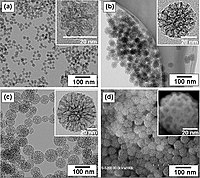
Photo from wikipedia
Xe+Xe collisions at relativistic energies provide us with an opportunity to study a possible system with deconfined quarks and gluons, whose size is in between those produced by p+p and… Click to show full abstract
Xe+Xe collisions at relativistic energies provide us with an opportunity to study a possible system with deconfined quarks and gluons, whose size is in between those produced by p+p and Pb+Pb collisions. In the present work, we have used AMPT transport model with nuclear deformation to study the identified particle production such as ($\pi^{+}+\pi^{-}$), (K$^{+}$+K$^{-}$), $\rm{K}_{s}^0$, (p+$\bar{\rm{p}}$), $\phi$ and ($\Lambda + \bar{\Lambda}$) in Xe+Xe collisions at $\sqrt{s_{\rm NN}}$=5.44 TeV. We study the $p\rm{_T}$-spectra, integrated yield, $p\rm{_T}$-differential and $p\rm{_T}$-integrated particle ratios to ($\pi^{+}+\pi^{-}$) and (K$^{+}$+K$^{-}$) as a function of collision centrality. The particle ratios are focused on strange to non-strange ratios and baryon to meson ratios. The effect of deformations has also been highlighted by comparing our results to non-deformation case. We have also compared the results from AMPT string melting and AMPT default version to explore possible effects of coalescence mechanism. We observe that the differential particle ratios show strong dependence with centrality while the integrated particle ratios show no centrality dependence.We give thermal model estimation of chemical freeze-out temperature and the Boltzmann-Gibbs Blast Wave analysis of kinetic freeze-out temperature and collective radial flow in Xe+Xe collisions at $\sqrt{s_{\rm{NN}}}$ = 5.44 TeV.
Journal Title: Physical Review C
Year Published: 2019
Link to full text (if available)
Share on Social Media: Sign Up to like & get
recommendations!